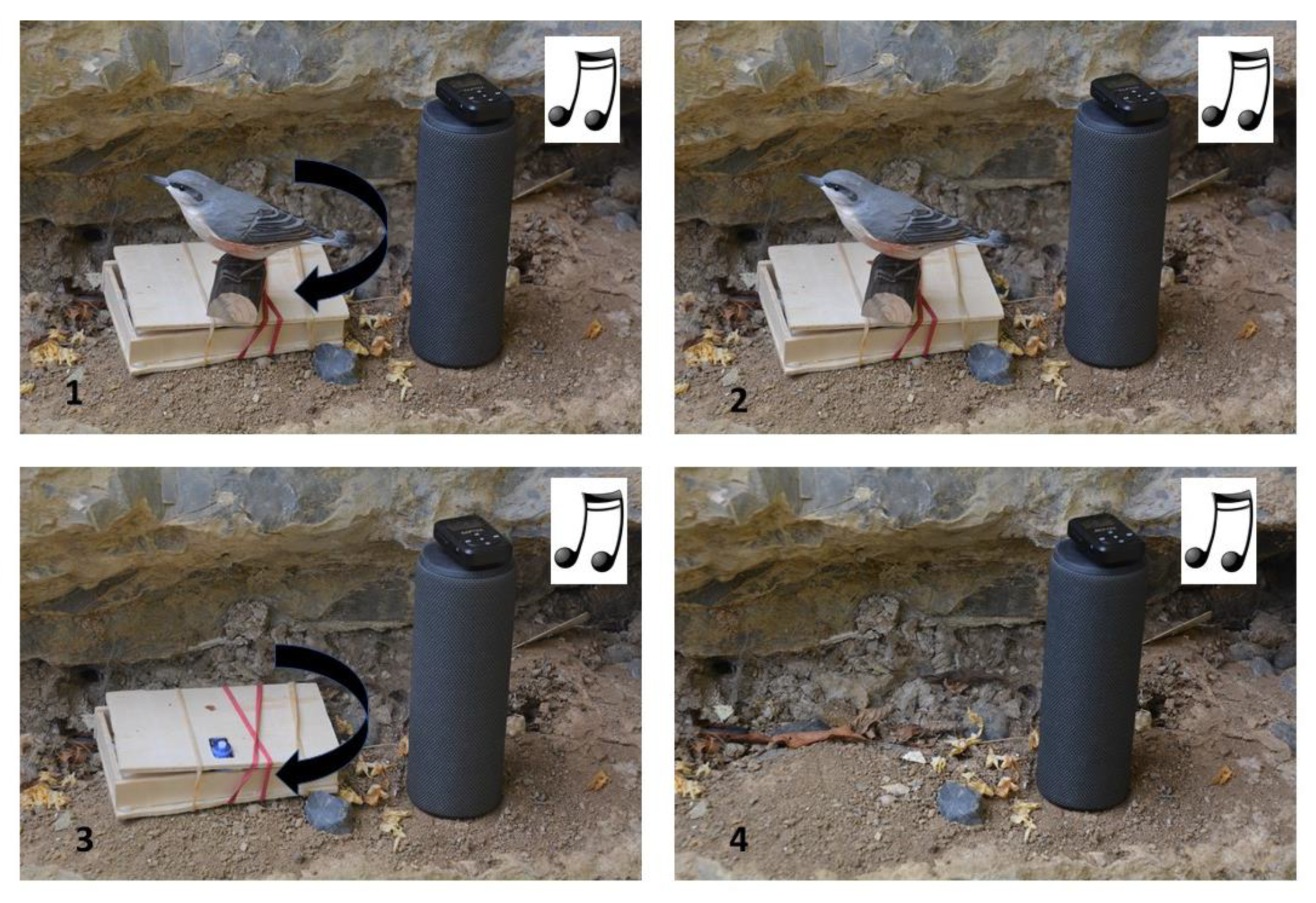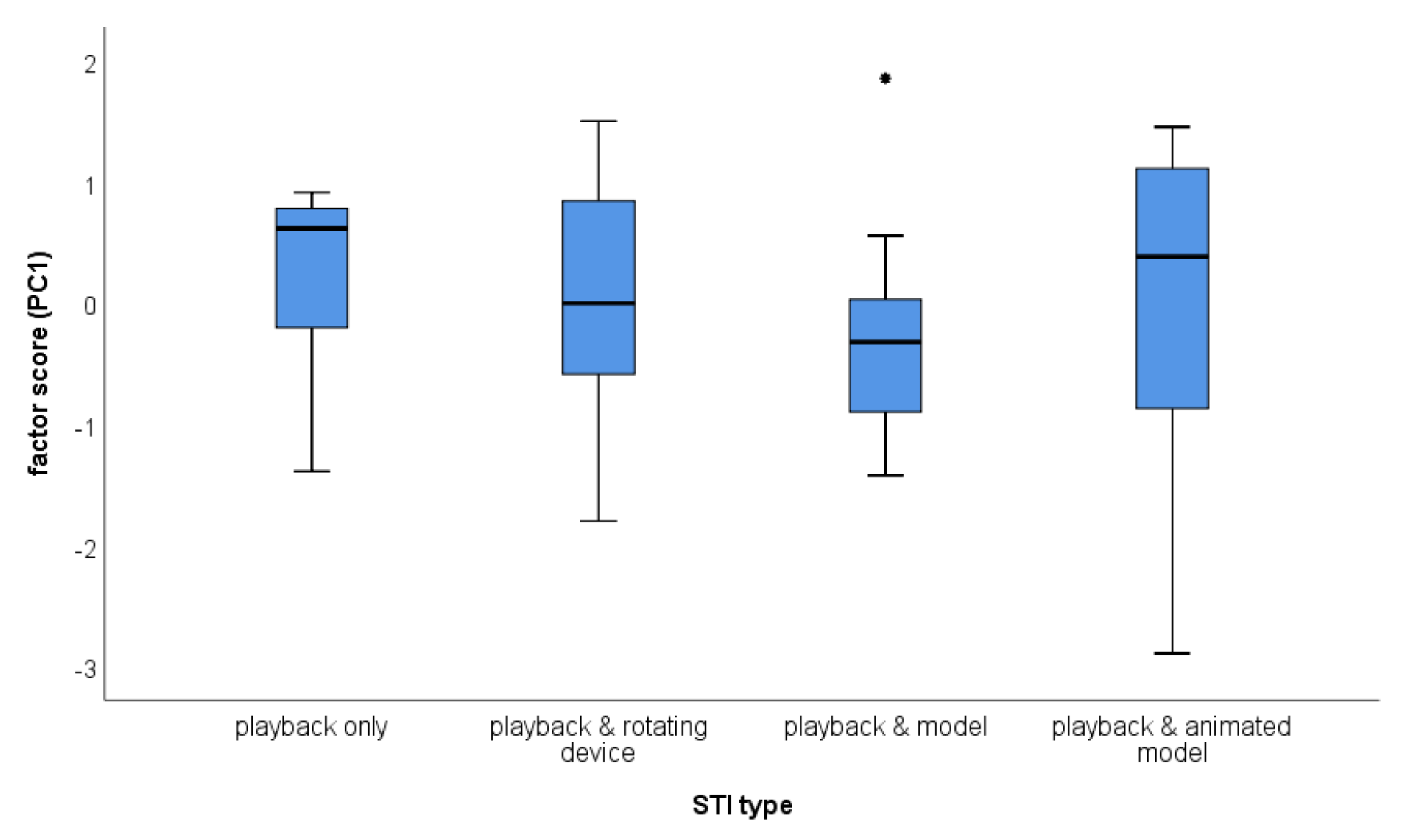Territorial Responses of Nuthatches Sitta europaea—Evaluation of a Robot Model in a Simulated Territorial Intrusion †
Abstract
Simple Summary
Abstract
1. Introduction
2. Materials and Methods
2.1. The Species
2.2. Fieldwork
- Playback of calls and model and robot device in motion (mounted onto the device and in motion);
- Playback of calls and model presentation (mounted on the device but motionless);
- Playback of calls and robot device in motion, but without a model (no mount on the device, but device in motion);
- Playback of calls.
2.3. Variables
2.4. Ethical Note
2.5. Statistical Analysis
3. Results
4. Discussion
Author Contributions
Funding
Acknowledgments
Conflicts of Interest
References
- Schwabl, H. Winter and Breeding Territorial Behaviour and Levels of Reproductive Hormones of Migratory European Robins. Ornis Scand. 1992, 23, 271. [Google Scholar] [CrossRef]
- Wingfield, J.C. Regulation of Territorial Behavior in the Sedentary Song Sparrow, Melospiza melodia morphna. Horm. Behav. 1994, 28, 1–15. [Google Scholar] [CrossRef] [PubMed]
- Lenis, P.R.; Guillermo-Ferreira, R. Effect of noise on behavioural response to simulated territorial intrusion in the Great Kiskadee (Pitangus sulphuratus) (Aves: Tyrannidae). Urban Ecosyst. 2019, 23, 93–96. [Google Scholar] [CrossRef]
- Ansell, D.; Magrath, R.D.; Haff, T.M. Song matching in a long-lived, sedentary bird with a low song rate: The importance of song type, song duration and intrusion. Ethology 2020, 126, 1098–1110. [Google Scholar] [CrossRef]
- Beecher, M.D.; Campbell, S.; Burt, J.M.; Hill, C.E.; Nordby, J. Song-type matching between neighbouring song sparrows. Anim. Behav. 2000, 59, 21–27. [Google Scholar] [CrossRef]
- Randler, C.; Förschler, M.I.; González, J.; Aliabadian, M.; Bairlein, F.; Wink, M. Phylogeography, pre-zygotic isolation and taxonomic status in the endemic Cyprus Wheatear Oenanthe cypriaca. J. Ornithol. 2012, 153, 303–312. [Google Scholar] [CrossRef]
- Jin, L.; Liang, J.; Fan, Q.; Yu, J.; Sun, K.; Wang, H. Male Great Tits (Parus major) adjust dear enemy effect expression in different breeding stages. J. Ornithol. 2020, 1–9. [Google Scholar] [CrossRef]
- Landys, M.M.; Goymann, W.; Schwabl, I.; Trapschuh, M.; Slagsvold, T. Impact of season and social challenge on testosterone and corticosterone levels in a year-round territorial bird. Horm. Behav. 2010, 58, 317–325. [Google Scholar] [CrossRef]
- Matthysen, E.R.I.K. Some observations on sex-specific territoriality in the nuthatch. Ardea 1986, 74, 177–183. [Google Scholar]
- Tryjanowski, P.; Morelli, F.; Osiejuk, T.S.; Møller, A.P. Functional significance of cuckoo Cuculus canorus calls: Responses of conspecifics, hosts and non-hosts. PeerJ 2018, 6, e5302. [Google Scholar] [CrossRef]
- Akçay, Ç.; Tom, M.E.; Holmes, D.; Campbell, S.E.; Beecher, M.D. Sing softly and carry a big stick: Signals of aggressive intent in the song sparrow. Anim. Behav. 2011, 82, 377–382. [Google Scholar] [CrossRef]
- Darolová, A.; Krištofík, J.; Knauer, F.; Hoi, H. Behavioural response of Eurasian Blackcaps to acoustically simulated conspecific and heterospecific male intruders. J. Ornithol. 2020, 161, 447–458. [Google Scholar] [CrossRef]
- Laidre, M.E.; Vehrencamp, S.L. Is bird song a reliable signal of aggressive intent? Behav. Ecol. Sociobiol. 2007, 62, 1207–1211. [Google Scholar] [CrossRef] [PubMed]
- Tryjanowski, P.; Morelli, F.; Kwieciński, Z.; Indykiewicz, P.; Møller, A.P. Birds respond similarly to taxidermic models and live cuckoos Cuculus canorus. J. Ethol. 2018, 36, 243–249. [Google Scholar] [CrossRef]
- Bentz, A.B.; Philippi, K.J.; Rosvall, K.A. Evaluating seasonal patterns of female aggression: Case study in a cavity-nesting bird with intense female–female competition. Ethology 2019, 125, 555–564. [Google Scholar] [CrossRef]
- Patricelli, G. Robotics in the Study of Animal Behavior. In Encyclopedia of Animal Behavior; Elsevier BV: Amsterdam, The Netherlands, 2010; Volume 3, pp. 91–99. [Google Scholar]
- Belinsky, K.L.; Nemes, C.E.; Schmidt, K.A. Two Novel Vocalizations Are Used by Veeries (Catharus fuscescens) during Agonistic Interactions. PLoS ONE 2015, 10, e0120933. [Google Scholar] [CrossRef]
- Ręk, P.; Magrath, R.D. Multimodal duetting in magpie-larks: How do vocal and visual components contribute to a cooperative signal’s function? Anim. Behav. 2016, 117, 35–42. [Google Scholar] [CrossRef]
- Carlson, N.V.; Pargeter, H.M.; Templeton, C.N. Sparrowhawk movement, calling, and presence of dead conspecifics differentially impact blue tit (Cyanistes caeruleus) vocal and behavioral mobbing responses. Behav. Ecol. Sociobiol. 2017, 71, 133. [Google Scholar] [CrossRef]
- Frohnwieser, A.; Murray, J.C.; Pike, T.W.; Wilkinson, A. Using robots to understand animal cognition. J. Exp. Anal. Behav. 2016, 105, 14–22. [Google Scholar] [CrossRef]
- Krause, J.; Winfield, A.F.T.; Deneubourg, J.-L. Interactive robots in experimental biology. Trends Ecol. Evol. 2011, 26, 369–375. [Google Scholar] [CrossRef]
- Barnett, C.A.; Sakaluk, S.K.; Thompson, C.F. Aggressive displays by male House Wrens are composed of multiple components that predict attack. J. Field Ornithol. 2014, 85, 56–62. [Google Scholar] [CrossRef]
- Billerman, S.M.; Carling, M.D. Differences in aggressive responses do not contribute to shifts in a sapsucker hybrid zone. Auk Ornithol. Adv. 2017, 134, 202–214. [Google Scholar] [CrossRef]
- Byers, B.E. Chestnut-sided warblers use rare song types in extreme aggressive contexts. Anim. Behav. 2017, 125, 33–39. [Google Scholar] [CrossRef]
- Randler, C. Verhaltensbiologie; Haupt Verlag: Bern, Switzerland, 2018. [Google Scholar]
- Marasco, V.; Fusani, L.; Dessì-Fulgheri, F.; Canoine, V. Non-migratory stonechats show seasonal changes in the hormonal regulation of non-seasonal territorial aggression. Horm. Behav. 2011, 60, 414–419. [Google Scholar] [CrossRef] [PubMed]
- Enoksson, B.; Nilsson, S.G. Territory Size and Population Density in Relation to Food Supply in the Nuthatch Sitta europaea (Aves). J. Anim. Ecol. 1983, 52, 927. [Google Scholar] [CrossRef]
- Goymann, W.; Landys, M.M. Testosterone and year-round territoriality in tropical and non-tropical songbirds. J. Avian Biol. 2011, 42, 485–489. [Google Scholar] [CrossRef]
- Bezzel, E. Kompendium der Vögel Mitteleuropas. 2. Passeres-Singvögel; Aula-Verlag: Wiesbaden, Germany, 1993. [Google Scholar]
- Löhrl, H. Die Kleiber Europas. Neue Brehm Bücherei, 2nd ed.; A. Ziemsen Verlag: Lutherstadt—Wittenberg, Germany, 1967; p. 120. [Google Scholar]
- Matthysen, E. The Nuthatches; TAD Poyser: London, UK, 1998; p. 315. [Google Scholar]
- Löhrl, H. Das Verhalten des Kleibers (Sitta europaea caesia Wolf). Z. Tierpsychol. 2010, 15, 191–252. [Google Scholar] [CrossRef]
- Enoksson, B. Autumn Territories and Population Regulation in the Nuthatch Sitta europaea: An Experimental Study. J. Anim. Ecol. 1990, 59, 1047. [Google Scholar] [CrossRef]
- Matthysen, E. Behavioral and ecological correlates of territory quality in the Eurasian Nuthatch (Sitta europaea). Auk 1990, 107, 86–95. [Google Scholar]
- Naďo, L.; Kašová, M.; Krištín, A.; Kaňuch, P. Cooperative nest-defence behaviour and territory quality in a resident and socially monogamous passerine. Ethology 2018, 124, 514–526. [Google Scholar] [CrossRef]
- Randler, C. Ein Beitrag zum Invasionsvogel Kleiber Sitta europaea caesia. Ornithol. Jahresh. Bad. Württ. 1997, 13, 145–160. [Google Scholar]
- Kalb, N.; Anger, F.; Randler, C. Subtle variations in mobbing calls are predator-specific in great tits (Parus major). Sci. Rep. 2019, 9, 6572. [Google Scholar] [CrossRef] [PubMed]
- Kalb, N.; Anger, F.; Randler, C. Great tits encode contextual information in their food and mobbing calls. R. Soc. Open Sci. 2019, 6, 191210. [Google Scholar] [CrossRef]
- Altmann, J. Observational Study of Behavior: Sampling Methods. Behaviour 1974, 49, 227–266. [Google Scholar] [CrossRef] [PubMed]
- Templeton, C.N.; Greene, E. Nuthatches eavesdrop on variations in heterospecific chickadee mobbing alarm calls. Proc. Natl. Acad. Sci. USA 2007, 104, 5479–5482. [Google Scholar] [CrossRef] [PubMed]
- Kalb, N.; Randler, C. Behavioral responses to conspecific mobbing calls are predator-specific in great tits (Parus major). Ecol. Evol. 2019, 9, 9207–9213. [Google Scholar] [CrossRef]
- White, P.J.C. Song characteristics vary clinally across an active colonization zone in Eurasian Nuthatches Sitta europaea. Bird Study 2012, 59, 296–302. [Google Scholar] [CrossRef]



| Source | Location | Territories Used |
|---|---|---|
| Kleiber Bergmann | DVD | 2 |
| https://www.xeno-canto.org/418019 | Heidelberg/BW/Germany | 2 |
| https://www.xeno-canto.org/489437 | Spreewald/BB/Germany | 1 |
| https://www.xeno-canto.org/399395 | Augsburg/BY/Germany | 3 |
| https://www.xeno-canto.org/118485 | Roccatederighi, Grosseto/Italy | 1 |
| https://www.xeno-canto.org/127154 | Berlin/Germany | 1 |
| https://www.xeno-canto.org/206405 | Stromberg/BW/Germany | 2 |
| Type | Latency to Approach (s) | Latency to Call (s) | Fly Overs | Time Spent in Same Tree (s) | Minimum Distance (m) | Calls | Individ. | In & Out Tree |
|---|---|---|---|---|---|---|---|---|
| Control/baseline | 360 | 182 | 0.0 | 0.0 | 58.6 | 15.2 | 0.83 | 0.0 |
| Call & animated model (1) | 137 | 125 | 0.92 | 67.00 | 19.6 | 90 | 1.67 | 1.25 |
| Call & motionless model (2) | 144 | 102 | 0.50 | 29.58 | 21.4 | 78 | 1.58 | 0.50 |
| Call & robot device in motion (3) | 138 | 109 | 1.92 | 32.50 | 12.2 | 137 | 1.50 | 0.83 |
| Call only (4) | 127 | 91 | 1.33 | 57.83 | 11.5 | 93 | 1.75 | 1.25 |
| Factor 1 | Factor 1 | |
|---|---|---|
| Including Baseline (N = 60) | STI Experiments Only (N = 48) | |
| Latency to approach | −0.861 | −0.811 |
| Latency to call | −0.603 | −0.556 |
| Time spent in the same tree | 0.724 | 0.722 |
| fly-overs | 0.582 | 0.573 |
| Minimum distance (m) | −0.866 | −0.823 |
| individuals | 0.771 | 0.643 |
| flights into the tree | 0.678 | 0.659 |
| calls | 0.444 | 0.371 |
| Source | df | df | F | p |
|---|---|---|---|---|
| Constant | 1 | 8.026 | 0.005 | 0.947 |
| Stimulus | 3 | 10.958 | 1.000 | 0.429 |
| Order | 3 | 18.283 | 10.219 | <0.001 |
| Stimulus * order | 9 | 13.486 | 1.069 | 0.441 |
Publisher’s Note: MDPI stays neutral with regard to jurisdictional claims in published maps and institutional affiliations. |
© 2020 by the authors. Licensee MDPI, Basel, Switzerland. This article is an open access article distributed under the terms and conditions of the Creative Commons Attribution (CC BY) license (http://creativecommons.org/licenses/by/4.0/).
Share and Cite
Randler, C.; Randler, E. Territorial Responses of Nuthatches Sitta europaea—Evaluation of a Robot Model in a Simulated Territorial Intrusion. Birds 2020, 1, 53-63. https://doi.org/10.3390/birds1010006
Randler C, Randler E. Territorial Responses of Nuthatches Sitta europaea—Evaluation of a Robot Model in a Simulated Territorial Intrusion. Birds. 2020; 1(1):53-63. https://doi.org/10.3390/birds1010006
Chicago/Turabian StyleRandler, Christoph, and Erik Randler. 2020. "Territorial Responses of Nuthatches Sitta europaea—Evaluation of a Robot Model in a Simulated Territorial Intrusion" Birds 1, no. 1: 53-63. https://doi.org/10.3390/birds1010006
APA StyleRandler, C., & Randler, E. (2020). Territorial Responses of Nuthatches Sitta europaea—Evaluation of a Robot Model in a Simulated Territorial Intrusion. Birds, 1(1), 53-63. https://doi.org/10.3390/birds1010006






